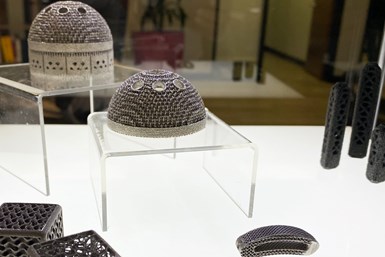PrinterPrezz/Vertex Manufacturing Rebrands to Zeda
The rebranding is said to reflect the company’s “Z to A” approach, which means it starts first with the customer in mind and ends with a product.
As a startup, PrinterPrezz focused on implant development, approval and production via additive manufacturing and includes surgeons among its founders.
PrinterPrezz Inc. and its subsidiary Vertex Manufacturing — a provider of advanced 3D manufacturing and nanotech solutions for the medical, space, defense and aerospace industries — has rebranded itself and is operating under the new company name Zeda Inc.
The company says the Zeda name reflects its “Z to A” approach, which means it starts first with the customer in mind and ends with a product. PrinterPrezz Inc. and its subsidiary Vertex Manufacturing have rebranded to operate under the new company name Zeda Inc.
The name is also said to represent the strength of both companies and their progress in the last five years in their target markets by combining cutting-edge advanced manufacturing processes with semiconductor technologies.
Initially created to address the evolving needs of the orthopedic devices industry, the company has partnered with companies in regulated industries, such as medical, defense, semiconductors and aerospace.
It is said the newly rebranded company has grown exponentially organically and through strategic acquisitions. Vertex was one such acquisition, and was founded and led by manufacturing pioneer Greg Morris who now serves as Zeda’s CTO.
Zeda now has 140,000 square feet across multiple advanced facilities in California, New Jersey, Ohio and Singapore.
“In 2018, we entered a new territory with advanced manufacturing of medical devices for the global orthopedic market. By combining advanced manufacturing processes, like 3D printing, with technologies from the semiconductor industry, we are able to customize and reduce the cost of medical devices for the global population,” says Shri Shetty, Zeda CEO. “It wasn’t long before we realized that the fusion of these technologies could revolutionize not just health care but advancements in the space, defense, semiconductor and aerospace industries. Zeda reflects where we came from, where we are today and where we intend to go.”
Morris says this is the next chapter in its growth.“As one brand, we are in a stronger position to leverage the full capabilities of both companies more effectively,” Morris adds. “Over the past year, our Cincinnati team has experienced unparalleled growth across all areas of our business, but most importantly, our existing customers can continue to trust and count on us.”
- Watch Vertex Manufacturing (Zeda) founder Greg Morris talk about how additive manufacturing is more than 3D printing and the importance of complementary capabilities such as machining, inspection and other operations.
- Learn how PrinterPrezz (Zeda) aimed to realize a manufacturing model tailored to medical devices as a startup focused on implant development, approval and production via additive manufacturing and included surgeons among its founders.
Related Content
-
Overcoming Challenges with 3D Printing Nitinol (and Other Oxygen-Sensitive Alloys) Through Atmospheric Control
3D printed nitinol has potential applications in dental, medical and more but oxygen pickup can make this material challenging to process. Linde shares how atmospheric monitoring and the use of special gas mixtures can help maintain the correct atmosphere for printing this shape alloy and other metals.
-
8 Cool Parts From Formnext 2023: The Cool Parts Show #65
New additive manufacturing technologies on display at Formnext were in many cases producing notable end-use components. Here are some of the coolest parts we found at this year’s show.
-
Durable, Waterproof 3D Printed Casts: The Cool Parts Show #58
Recovering from an injury with an ActivArmor cast means that patients can exercise, bathe and live life while they heal. We get a firsthand look at the solution in this episode of The Cool Parts Show.















